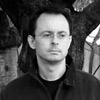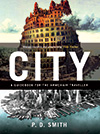04 July 2007 | cold war, Doomsday Machine, Doomsday Men |
John Gribbin has said some nice things about Doomsday Men in a review for this month's Literary Review:
"It is an impassioned account of everything from the discovery of radioactivity to plans for a Doomsday Device (yes, there really were such plans) from an author who feels that to the generations growing up who see the Cold War only as something in history books, the true horror of nuclear weapons has been forgotten. While politicians talk glibly of 'weapons of mass destruction', nobody has any real feeling for what it means to experience intense machine gun fire, the kind of bombing that destroyed Dresden, or a nuclear holocaust. Nor do many people know that there are still about 30,000 nuclear weapons still ready for launch around the world. Doomsday Men aims to address that gap, focusing on nuclear weapons, but also looking at other forms of mass destruction."
He concludes that Doomsday Men is "important, and, depressingly, there is a need for it - people, especially younger people than me, ought to read it".
03 July 2007 | Doomsday Men, Dr Strangelove, Kahn, Kubrick, Roshwald, SF, Shute, Wells, WMD |
Author Andrew Robinson has written a perceptive review of Doomsday Men for this month's Physics World. Unfortunately, it's not available on-line unless you are a subscriber. However, I can tell you that he describes my book as "a chillingly compelling history of chemical, biological and atomic superweapons". He continues:
"Doomsday Men analyses dozens of examples of how culture influenced science in the devising of superweapons. They range from the prophetic writings of HG Wells, and the science fiction published in Amazing Stories and other magazines in the 1920s and 1930s, to highly influential post-atomic-bomb novels such as Nevil Shute's On the Beach and Mordecai Roshwald's Level 7. And, of course, there is the darkly comic film Dr Strangelove, directed by Stanley Kubrick in 1963, in which the story centres around the 'doomsday machine' - a phrase originally coined by gung-ho phyisicst Herman Kahn."
Robinson concludes that Doomsday Men "successfully shows how and why superweapons have been simultaneously admired and reviled by both scientists and the public."
30 June 2007 | Doomsday Men, Einstein, H-bomb, SF, Szilard |
Novelist Tibor Fischer has written a great review of my book, Doomsday Men in today's Daily Telegraph. I just thought I'd share a few quotes with you:
"Doomsday Men doesn't just deal with thermonuclear destruction. It's a meticulous account of weapons of mass destruction and the science and scientists behind them. Indeed, it is two books for the price of one, because it is also a cultural disquisition. Smith scours fiction for visions of death rays and lurid imaginings of Armageddon to show how writers often preceded or influenced scientists."
As well as describing Doomsday Men as "readable and entertaining", Fischer thinks I deserve "some sort of award for value for money". Well at least you know that if you buy my book, you're not being short-changed!
You can read the whole review, "But, Herr Einstein, that's nonsense!", here.
28 June 2007 | Reviewing, Science & literature, Writing & Poetry |
 I've just been reviewing a fascinating new book on German-speaking exiles in Los Angeles during the 1940s and 50s - Erhard Bahr's Weimar on the Pacific. (Only Thomas Mann could look as miserable as that in California.) As many as 15,000 refugees from fascism made their way to California, most ending up in the city of the angels - although Brecht rather ungratefully likened the city to hell. They included Arnold Schoenberg, Fritz Lang, Franz Werfel, and Alfred Döblin.
I've just been reviewing a fascinating new book on German-speaking exiles in Los Angeles during the 1940s and 50s - Erhard Bahr's Weimar on the Pacific. (Only Thomas Mann could look as miserable as that in California.) As many as 15,000 refugees from fascism made their way to California, most ending up in the city of the angels - although Brecht rather ungratefully likened the city to hell. They included Arnold Schoenberg, Fritz Lang, Franz Werfel, and Alfred Döblin.
Some, like Brecht, were hard-boiled former residents of the sin city that was Berlin in the 1920s and they felt alienated (for want of a better word) in this verdant, Arcadian city. Döblin for one complained about the lush greenness that he saw everywhere. Reading this reminded me of an article I did a while back on Döblin's wonderful modernist novel, Berlin Alexanderplatz (1929), for Alan Ross's London Magazine. As I don't suppose it's available online, I thought I'd post it on my own site. It explores the scientific themes in the novel and shows how these are rooted in Döblin's own training in psychiatry. He was one of many German-speaking writers in the twentieth century who had a scientific background and who often brought science into their work. If you've not read Döblin's novel, I'd certainly recommend it. And to get you in the mood, you can read my article here.
23 June 2007 | Bentham, Dawkins, Einstein, Kafka, Kafka's mouse, Science & literature, UCL, Writing & Poetry |
Just in case any of you are wondering why I called this site 'Kafka's mouse' (and I know some of you are), you might like to read this piece I've just written for the Independent. They asked me to write about my 'Book of a Lifetime' and I decided to bend the rules slightly and to do one on a short story. Here it is:
I first read Kafka’s story “Josephine the Singer, or the Mouse- folk” when I was studying German literature. It has haunted me ever since. It was written in March 1924, three months before Kafka died. He had tuberculosis of the larynx, and was unable to speak - a poignant background for a story about a singer. But it was Kafka’s writing, not his tragic life, that made such an impression on me.
Although the title tells us this is a story about mice, the word is never used. You become uncomfortably aware that he is writing about us. Part of Kafka’s genius is to trick the reader into seeing our own world differently. When Josephine sings, her audience is transfixed without knowing why. The narrator cannot pin down what it is about her singing that means so much to them. They listen in utter silence and sometimes it is difficult to tell whether it is the singing or the stillness that surrounds her voice that is so compelling. Paradoxically, those listening feel her voice is nothing special; but there is an elusive quality that moves them: “Something of our poor brief childhood is in it, something of lost happiness that can never be found again, but also something of active daily life, of its small gaieties”.
Tucked away at the back of the collection Wedding Preparations in the Country and Other Stories, translated beautifully by Willa and Edwin Muir, the story is a remarkable meditation on the power of art and its place in society. Kafka is the narrator and the artist, criticising Josephine (who has disappeared, presumably in a fit of primadonna pique) while also celebrating art’s ability to see beyond the mundane world. The disturbing strangeness of his other works is absent - at least on the surface. But the wonderful ambiguities that Kafka delights in (or was tormented by) are here, as is his unique sensitivity: he saw shades of psychological subtlety in situations that most would scarcely notice.
As a lecturer at University College London, I started writing a Kafkaesque novel about academic life. To whom else could you turn in a university where the institution’s founder, Jeremy Bentham, is kept mummified in a glass case in the entrance hall? Later, while researching the lives of scientists, I was struck by the parallels between Josephine’s honoured role in her society and the way we idolise scientists such as Einstein, whom Kafka met in Prague. After all, the greatest science - as Richard Dawkins has said - allows us to “hear the galaxies sing”. Whether Josephine represents science or art, to me her singing symbolises what life is about: the quest to understand ourselves and our place in the universe. Such songs are difficult if not impossible to describe in words. But like love, they infuse life with meaning.
 I've just been reviewing a fascinating new book on German-speaking exiles in Los Angeles during the 1940s and 50s - Erhard Bahr's
I've just been reviewing a fascinating new book on German-speaking exiles in Los Angeles during the 1940s and 50s - Erhard Bahr's 
